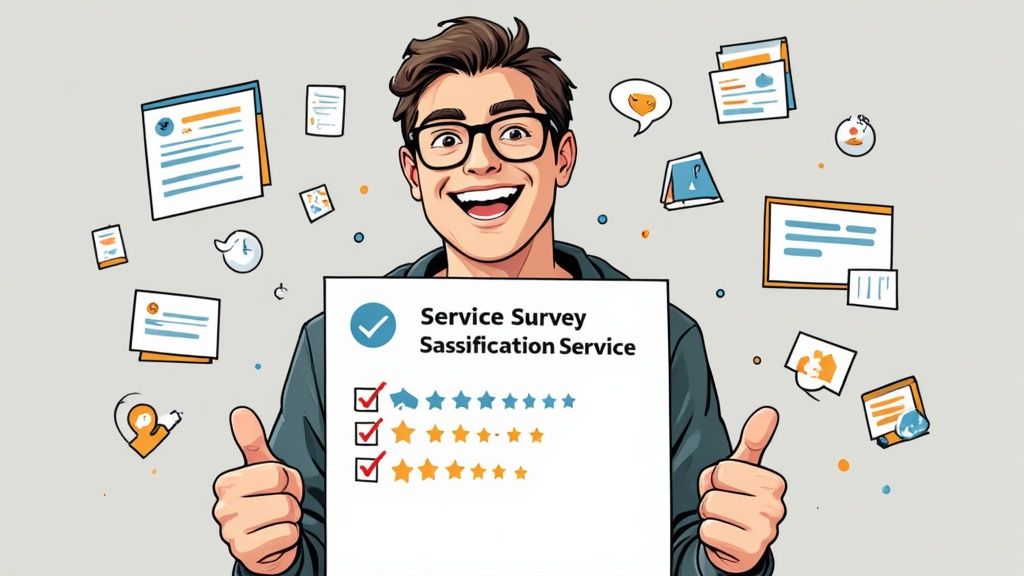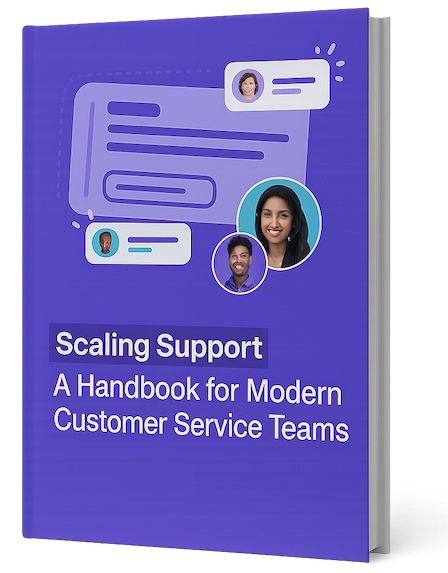Understanding Modern Quality Assurance for Services
Quality assurance has evolved into a strategic approach focused on ensuring outstanding customer experiences. With increased service complexity and heightened focus on regulatory compliance, today's QA must be proactive, predictive, and integrated across all service delivery aspects.
Key Differences Between QA and QC
Quality assurance (QA) and quality control (QC) serve different purposes in quality management. QA focuses on preventing defects through robust system design, while QC identifies and fixes issues after they occur. Think of QA as creating the blueprint and QC as inspecting the final building. Both elements work together as essential parts of quality management.
The Expanding Market for Quality Assurance
The QA services market shows strong growth potential. Market research indicates it will reach USD 12.9 billion by 2031, with a CAGR of 11.2% from 2024 to 2031. These numbers highlight how businesses increasingly value quality service delivery. For more details, see Verified Market Research.
Modern QA: A Proactive Approach
Today's quality assurance takes a forward-looking approach through:
- Predictive Quality Monitoring: Using data analytics to spot potential issues early
- Continuous Improvement: Regular process evaluation and enhancement
- Customer-Centric Approach: Building QA around customer needs
- Employee Empowerment: Giving teams the right training and tools
Consider a software company using analytics to identify patterns in customer complaints about specific features. By addressing root causes early, they prevent future issues and boost satisfaction. This approach reduces costs compared to reactive problem-solving, showing the value of prevention over correction.
Building Strong Quality Foundations Through Regulatory Excellence

Smart businesses know that following regulations isn't just about checking boxes – it's an opportunity to improve service quality and build customer confidence. When done right, strong compliance practices can set your organization apart from competitors.
Creating Value Through Compliance
Following regulations is essential for business success, not just legal requirements. Companies that align their quality assurance processes with industry standards demonstrate their commitment to reliability and security. This builds trust, especially in heavily regulated industries.
Consider a financial company that implements security measures beyond minimum requirements. By going above and beyond to protect customer data, they strengthen their reputation and attract security-minded clients. This shows how meeting regulations can drive real business value.
Building Strong Quality and Compliance Programs
Creating effective quality assurance programs centered on compliance takes careful planning. Success requires embedding compliance into every aspect of service delivery, not just meeting minimum standards.
- Know Your Requirements: Research and understand the specific regulations that apply to your industry to build a solid foundation
- Create Clear Guidelines: Write detailed policies and procedures that spell out expectations for everyone involved in service delivery
- Train Your Team: Give staff the knowledge they need through thorough training programs so they can follow compliance requirements properly
- Track and Review: Set up regular monitoring and auditing to ensure standards are met, using data to spot potential issues early
The need for strong compliance is driving growth in quality assurance services. As regulations become more complex, businesses need robust QA programs. For example, healthcare organizations must meet strict HIPAA data protection standards.
Looking Ahead
Regulations change constantly. To maintain both compliance and competitive edge, businesses must stay ahead of new requirements. This proactive approach helps avoid disruptions.
Key strategies include:
- Monitor Changes: Keep up with upcoming regulations by following industry news and participating in professional groups
- Build Adaptable Systems: Design QA processes that can evolve as requirements change
- Get Expert Input: Work with compliance specialists to understand and implement new regulations effectively
By making compliance a core part of quality assurance and taking a proactive approach, organizations can build customer trust while meeting regulatory requirements. This foundation supports long-term success as regulations continue to evolve.
Analytics as a Foundation for Quality Excellence

Quality assurance depends heavily on data and insights. By using analytics effectively, companies can spot issues before they impact customers, rather than just reacting to problems after the fact. This helps teams make smart decisions and deliver consistently great service.
Key Quality Metrics That Matter
The first step is identifying the right metrics to track. These Key Performance Indicators (KPIs) vary by business, but important ones include:
- Customer Satisfaction (CSAT): Shows how happy customers are with your service
- Net Promoter Score (NPS): Measures customer loyalty and recommendations
- First Response Time (FRT): Tracks how quickly you respond to customers
- Resolution Time: Shows how long it takes to solve issues
These numbers tell you different aspects of service quality. By monitoring them closely, you can spot trends and make targeted improvements. Choosing metrics that align with your goals is essential.
Predicting Quality Issues Early
Modern analytics help catch problems before they happen. Predictive quality monitoring looks at past data to spot patterns and risks. For example, analyzing complaints can reveal recurring issues that need fixing.
This proactive approach reduces customer impact and saves money compared to fixing problems after they occur. It also helps teams address root causes for lasting improvements. Getting ahead of issues benefits both customers and the business.
Turning Data Into Action
Data only helps if you use it to make real changes. Analytics tools show trends visually, making it easier to identify what needs work. This helps teams focus their efforts on the most important areas.
Analytics insights can improve training, processes, and products. Quality becomes part of the whole company's strategy, not just one department's job. The data also shows ROI, helping justify investments in better quality management.
Contact centers show how analytics drives quality today. Over half now use analytics for core quality measures, with 68% using it specifically for quality assurance, according to recent statistics. This trend highlights how data improves quality results.
Building Analytics Skills in QA Teams
Adding analytics to quality teams takes planning. Key steps include:
- Training team members: Help staff learn data analysis skills
- Getting the right tools: Add platforms for data tracking and reporting
- Adding analytics experts: Bring in specialists to support QA efforts
These capabilities help teams use data effectively and keep improving. Investing in both people and tools leads to better quality assurance.
Building High-Impact Quality Monitoring Systems
To create excellent customer experiences, companies need strong quality monitoring systems that help teams consistently deliver great service. When designed well, these systems provide real-time feedback and promote ongoing improvements in how teams serve customers.
Defining Evaluation Criteria for Service Excellence
The key to effective monitoring starts with clear evaluation criteria that reflect what great service means for your business. For example, software support teams might focus on metrics like First Response Time and Customer Satisfaction scores. Consulting firms often evaluate client communication quality and project outcomes. By aligning monitoring with specific business goals and customer needs, teams can better track and improve their service delivery.
Implementing Feedback Loops That Drive Change
The best monitoring systems do more than collect data – they create clear paths for teams to improve. Regular performance reviews paired with specific, actionable feedback help service providers understand what they're doing well and where they can get better. For instance, instead of vague feedback like "improve communication," provide concrete examples and suggestions like "send project status updates every Friday" or "acknowledge all client emails within 2 hours."
Building Systems That Scale
As your organization grows, quality monitoring needs to grow too. Manual processes often break down with increased service volume. Tools like Supportman help by integrating feedback directly into communication platforms like Slack, making insights readily available. Clear dashboards that show key metrics help teams spot trends quickly. Consider using tiered monitoring approaches – focusing more attention on high-risk areas while maintaining baseline monitoring across all services.
Using Practical Metrics and Scorecards
Choose metrics that directly connect to your evaluation criteria and business goals. For example, if customer retention is your focus, track metrics like Customer Lifetime Value and Net Promoter Score rather than just satisfaction scores. Create scorecards that combine these metrics to show overall performance trends. Make sure scorecards offer clear insights that help teams understand how quality initiatives impact business results. Simple, focused metrics and scorecards help build a data-driven approach to service improvement.
Creating a Culture of Quality Excellence

Creating an environment focused on quality takes more than just implementing standard quality checks. It requires building a workplace where every person on the team values and contributes to excellent service. Quality needs to be woven into all aspects of the organization, from how new employees are trained to how performance is managed.
Engaging Employees in Quality Initiatives
Getting employees involved is essential for quality assurance to work well. Team members who understand how quality affects customer experiences are more likely to take part in making improvements. Start by clearly communicating your quality standards and what you expect. Make sure to give employees chances to share their ideas and help create solutions – this helps them feel ownership over quality goals.
Regular team meetings to discuss customer feedback and brainstorm fixes can boost engagement and lead to better quality assurance results. Tools like Supportman can help by making it easier to share and track customer feedback.
Developing Skills for Quality Service Delivery
Great service depends on having well-trained employees. Put resources into training programs that give teams the knowledge and tools needed to deliver excellent service. This could include product training, customer communication skills, or workshops on problem-solving. Ongoing coaching and mentoring also help reinforce good practices.
Make quality assurance an ongoing learning process, not just a one-time training. Keep investing in improving your team's abilities to meet changing customer needs and maintain high standards.
Reinforcing Quality Through Recognition and Rewards
When you recognize and reward employees who consistently deliver great service, it shows quality matters and motivates the team to maintain excellence. This can be as simple as verbal praise or as formal as awards programs and performance incentives. Recognition works best when tied to specific examples of quality work that clearly show how individual efforts improve overall service.
This creates positive motivation, encouraging employees to aim for quality since they know their work is valued. For example, sharing outstanding customer service examples in team meetings or highlighting positive customer feedback internally can inspire others.
Overcoming Resistance to Change
New quality programs often face pushback. Some team members may hesitate to adopt new processes or question their value. Address these concerns through clear communication about why changes are needed and how they'll help. Including employees in planning and implementing changes increases buy-in and reduces resistance.
Creating a strong quality culture takes time and persistence. You'll need patience and proactive problem-solving. It's important to show how quality initiatives benefit both customer satisfaction and employee success to maintain support and momentum. Focus on these key elements to build a lasting quality culture that drives ongoing improvement and delivers great service experiences.
Embracing Innovation in Quality Assurance

Quality assurance has changed significantly with new technology. Staying competitive requires adopting new tools that enhance service quality while making processes more efficient. The key players shaping this evolution are artificial intelligence (AI), automation, predictive analytics, and real-time monitoring.
AI and Automation: Making Quality Better and Faster
AI and automation help quality assurance teams work smarter. AI tools can spot trends in customer interactions to find areas that need improvement. This allows human agents to handle complex issues and give personalized support. Tasks like scheduling and reporting can be automated, reducing mistakes and saving time.
Predictive Analytics: Getting Ahead of Problems
Predictive analytics lets teams spot issues before they become major problems. By analyzing past customer behavior, companies can identify which customers might leave and take action to improve their experience early. This proactive approach helps keep customers happy and loyal.
Real-Time Monitoring: Keeping Service Standards High
Real-time monitoring shows how service is performing right now. Teams can catch and fix problems immediately, minimizing any negative impact on customers. Live dashboards display important metrics like customer satisfaction scores and resolution times, making it easy to track service quality continuously.
Adding New Tools to Your Process
Successfully adopting new quality assurance tools takes careful planning. Start by looking at your current quality framework and finding where new technology would help most. Choose tools that match your specific needs and goals. Make sure your team gets proper training so they can use these new tools effectively.
The Human Factor: Balancing People and Technology
While automation helps with routine tasks, human expertise remains essential. AI and automation handle the basics, but people are needed for complex problem-solving and building genuine customer connections. The key is finding the right mix of automation and human involvement. This means investing in training to help your team succeed as technology advances.
Want to streamline your customer service feedback and improve quality assurance? Supportman integrates Intercom ratings directly into Slack, giving your team real-time insights and fostering a culture of continuous improvement. Try it today!



